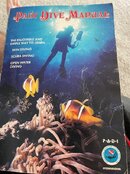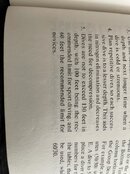This exact issue came up a year ago on another thread. I wrote a fairly long response which I'm going to copy here (with a little editing):
PADI is a member of the WRSTC [as is SDI, SSI, NAUI, RAID and a bunch of other agencies, but not CMAS or BSAC except BSAC Japan] and must follow its
standards.
It's interesting that the WRSTC has almost scrubbed the 40m certification limit from their site. For example there is no overall depth limit given in the Open Water diver standard. The only limits shown apply to the pre-certification training dives.
The recreational depth limit can only be found in two places. The first is in the WRSTC regional member application form. This is the form for certifying agencies who wish to join their regional council, not individual divers. The form states that members must be in the recreational diver certification business, which they define as:
An association, firm, corporation or other entity shall be deemed to be engaged primarily in the recreational diver certification business if more than sixty percent (60%) of its gross revenues are attributable to: the training and certifying of divers using compressed (atmospheric) air for no-decompression diving up to 130 feet/40 meters, the processing of recreational diver certification cards, membership dues from diving instructors and/or stores, the sale of recreational diver training and recreational diver instructor training materials, and fees for the training of recreational diving instructors.
Note that this limit only applies to compressed air. Which brings us to the second place the limit appears. The standard for Enriched Air Nitrox Diver states "5.2.2 All dives prior to enriched air certification shall be conducted at depths between 15 and 130 feet (5 to 40 metres)."
In other words training dives for a Nitrox class may go down to 40m. What about after certification?
Enriched Air Nitrox - WRSTC states "At its August 2006 meeting, the RSTC approved a standard for Enriched Air Nitrox diver. This standard is a recreational entry level nitrox diver standard for depths shallower than 130 feet/40 metres."
Note that AOW is not a prerequisite for Nitrox. It can't be because
there is no WRSTC standard for Advanced Open Water. As far as the WRSTC is concerned, AOW is the same as any other specialty course from drysuit diving to zombie apocalypse diving.
The only prerequisites for a Nitrox Diver course is that the diver be at least 15 years old, be OW certified, and have four (4) open water dives. The 4 dives can include the dives made during OW certification. So according to this standard an instructor could bring an OW diver to 40m on his or her very first dive as a certified diver as part of a Nitrox course. And once certified, the standard specifically allows dives to 40m. Finally, the course doesn't actually require any dives at all. So a diver with 0 logged dives after OW certification can obtain Nitrox certification, which we have already seen allows depths up to 40m.
Ok, so you don't want to go with all the legal mumbo jumbo about standards? Try PADI's blog post
How Deep Can You Scuba Dive?. Note that link is to the page on archive.org. The original was live on PADI's site a year ago, but PADI has since seen fit to scrub it. Perhaps too much truth can be bad for sales?
Many new divers are (understandably) confused about how deep you’re ‘allowed’ to dive as an Open Water Diver vs. an Advanced Open Water Diver. As a clever instructor once said, “at what depth will the scuba police pull you over?”
The maximum depth for recreational diving is 40 metres/130 feet .
There is, however, an important caveat: you should always dive within the limits of your training and experience. Open Water Divers* are trained to dive to a maximum depth of 18 metres/60 feet.
Can Open Water Divers dive deeper than 18 metres/60 feet? Frankly, yes. There are no scuba police out there to stop you (although some dive operations set depth limits and may have policies to deter divers from going beyond those limits)....
Why 40 metres/130 feet? There’s a bit of physics and physiology involved in a full explanation, but the short answer is: 40 metres/130 feet is the deepest you can dive without having to perform decompression stops on your way back to the surface. This depth limit is often referred to as the “no-decompression limit,” “NDL,” or “no-stop limit.” It’s also the depth at which most divers begin to feel the effects of gas narcosis (aka nitrogen narcosis). [emphasis in original]
Or from the PADI owned Scuba Diving Magazine -
Why is 130 Feet the Depth Limit for Recreational Scuba Diving?
So why has every major training agency established 130 feet — 40 meters — as the depth limit for recreational diving? In order to venture further and explore wrecks, caves and other sites beyond 130 feet, these agencies — such as PADI, NAUI and SSI — require “technical” certifications.
This precedent can be traced to the U.S. Navy, which established the rule in the 1950s and still requires special permission from a commanding officer for a diver to exceed this limit.
“The 130-foot limit is an arbitrary depth originally adopted by the U.S. Navy because it gave Navy divers about 10 minutes of (no-deco) time on compressed air; going any deeper on air made no sense to the Navy because the time available to do useful work was simply too short,” writes Lawrence Martin in Scuba Diving Explained: Questions & Answers on Physiology and Medical Aspects.




